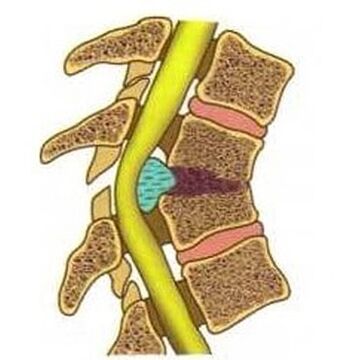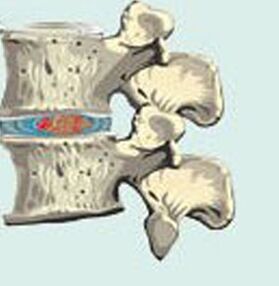Osteocondrosis is a degenerative dystrophic spinal disease, in which the injury of the intervertebral discs in the form of their deformation, reduction of height and stratification is noted. The manifestations of this pathology are different, but can be combined in different syndromes. Depending on the severity of the symptoms, the changes in the intervertebral discs that surround their structures, different phases of osteochondrosis are distinguished. Before treating osteochondrosis of the cervical region, it is important to find out why various drugs, physiotherapy and surgical methods are needed.

General information
The osteochondrosis of the cervical column develops more often in people over the age of 35, but sometimes its events are observed at the age of 18-30. The cervical column consists of vertebrae, the most mobile of them is generally influenced: the 5th, 6th, 7th.
Among the vertebrae there are intervertebral discs, which are a special form of the most resistant cartilage bone connection. They provide the ability of the spinal column to resist significant loads and its mobility.
Each intervertebral disc consists of:
- Mighty nucleus (jacket), which is a mass similar to the gel.
- Dense fibrous ring surrounding the core of the disc.
- Two thin white fibrous cartilage plates cover discs from above and below.
The intervertebral discs are connected to the bodies of the vertebrae using a binding apparatus.
The causes of osteochondosis
In people over the age of 20, the vases that feed intervertebral discs are invaded. In the future, these structures receive all the substances necessary by diffusion from a series of arranged vertebrae, but often these processes are insufficient for the normal metabolism in the discs.
The osteochondrosis of the cervical column develops more often under the influence of:
- Hereditary predisposition.
- Anatomical anomalies of the cervical region.
- Overweight.
- A sedentary lifestyle associated with sedentary work, the lack of physical effort.
- Spine trauma in the neck, including bruises, fractures.
- Metabolic disorders in the body.
- Changes related to age.
- Excessive physical effort.
- Frequent psycho -emotional stress.
These factors exacerbate the nutrition of intervertebral discs. As a result, the Polpeo nucleus is flattened, they become less elastic. The load on fibrous rings increases, which is accompanied by their elongation, by the formation of cracks in them.
Against the background of these degenerative changes, the intervertebral disc can protrude towards the spinal canal. The irritation of the rear longitudinal ligament rich in nervous terms is accompanied by local pain.

With the progression of the disease, a rupture of the rear longitudinal ligament occurs, the intervertebral disc is protruding in the cerebrospinal channel, this condition is called hernia. At the same time, the rooster syndrome is developing, caused by the irritation of the nearest cerebrospinal spine, local autoimmune inflammation. If the Radicolare-Spinae artery is crushed, the blood flow to the spinal cord is disturbed.
The osteochondrosis of the cervical column is accompanied by the formation of osteophytes: growth from bone tissue on bodies, vertebrae processes. These formations can also squeeze the roots of the spinal nerves or the spinal cord.
The first signs
The osteochondrosis of the Cervical-Theracic Department in the initial phase is accompanied by tension, a rapid effort of the muscles of this area. Subsequently, the discomfort, the pain in the neck, the neck, the shoulders, the intensification during the inclinations, the curves of the head come together.
Dizziness, headache - Another first sign of cervical osteochondosis in women, in men. Sometimes a person experiences pain, a feeling of numbness, tingling in his hands after a night sleep.
The main symptoms
The osteochondrosis of the cervical column is often characterized by:
- root syndrome;
- vertebral artery syndrome;
- Cardiological syndrome.
Some people have reflected dystrophic syndromes, record cervical myelopathy. Disorders in the emotional sphere, panic attacks with cervical osteochondrosis are often noted.
Rook syndrome
The manifestations of the root syndrome are caused by the compression (compression) of the root of the spinal nerves of the intervertebral discs, by the osteophytes of the bodies, by the processes of the vertebrae themselves. As a result of the compression of the nerve fibers, a local inflammatory reaction develops, which is accompanied by pain through the cold of the interested nerve.

Therefore, with cervical osteochondrosis, symptoms such as neck pain, hands, back areas occur. Unpleasant sensations can be seen in the heart, in the stomach. If neck pain remains constantly, it intensifies when turning, the tilting of the head, this condition is called cervicalgia. In addition, pain can have the character of Lumbago, giving in hand, they are called servants.
In those areas that innervates the interested nerve, there is a pronounced decision of sensitivity. The muscles in this area become weaker, their atrophy can be seen, which is accompanied by a decrease in their volume.
Vail artery syndrome
The vertebral artery is a coupled blood vessel that provides the blood flow to the brain of 15-30%. When the vertebral artery are tightened, the various chronic manifestations of insufficiency of oxygen in the central nervous system are noted by the altered intervertebral discs, the growth of the vertebrae.
In the development of this state, 2 stadiums are distinct: functional, organic (ischemic). In the first of them, the main symptoms of vertebral artery syndrome with cervical osteochondrosis are frequent headache. They become more pronounced in the movements of the head, as well as keeping a position for a long time. The pains are painful or buttons, adverse in the occipital areas, thunderstorms and fronts.
The dizziness for cervical osteochondrosis are also characteristics of the functional stage of this syndrome. Its intensity is different: from a feeling of instability to a sensation of sudden fall or rapid rotation of the body. Sometimes the hearing is reduced, a person can be disturbed by noise in the ears. Visual disorders are noted in the form of flies, flashes in front of the eyes.
With the progression of the pathology, the ischemic stadium occurs. It is characterized by temporary cerebral circulation disorders in the form of transient ischemic attacks, the occurrence of which is often caused by a rapid inclination or a turning point of the head.
Different options for vertebral artery syndrome are distinguished, with cervical osteochondosis, whose events have their characteristics:
- Fall attack.
- Barre-Rieou syndrome (rear cervical syndrome, cervical migraine).
- Base migraine.
- Syncopa vertebral syndrome.
- Ophthalmic syndrome.
- Vegetative dysfunction syndrome.
- Ophthalmic syndrome.
- Kochleo-Investbular syndrome.
- Transient ischemic attacks.
With a fall attack, a person suddenly falls, throws his head back, cannot move. The losses of consciousness are not noted, the ability to move independently after a few minutes. This condition is caused by an insufficient blood flow to the cerebellum, the brain trunk.
Cervical migraine syndrome occurs due to the compression of alternating interpretations or nerve plexus osteophytes surrounding the vertebral arteries. This condition is characterized by stupid headaches, which periodically become buttons. Usually they present themselves if you have to maintain a forced position of the head for a long time, for example, this often happens after sleeping on an uncomfortable pillow when working on the computer. These headaches for osteochondosis of the cervical region become stronger during the descent, climbing the stairs, trembling while driving in transport, fast walks. The pains are found on the one hand in the occipital region, they apply to the front parts of the head. They can persist from several minutes to hours.

The manifestations of the summary syndrome of syncopa occur due to the insufficient intake of oxygen to the reticular formation of the brain. This condition is accompanied by a short -term fainting, with a long stay of the head, the neck in a forced position.
The symptoms of cervical osteocondrosis in women, men in the form of pain, the feeling of sand in the eyes, the sparks in front of them are some of the manifestations of an ophthalmic syndrome. There is a decrease in visual acuity, which is more pronounced with a greater load on the eyes, a partial loss of vision fields is possible. The closure occurs, the redness of the conjunctiva is evident.
The attack of the basic migraine begins with a decrease in the vision of both eyes, noise in the ears, compromised pace, lubrication of language. There are also dizziness with cervical osteochondosis of this variant of the course. So there is a serious headache in the occipital region, accompanied by vomiting, the attack ends with a loss of consciousness.
With the development of a Cochleo-Investbular syndrome, when involving the pathological process of the vertebral artery in the ears, a person observes a decrease in hearing and a perception of whispering speech is particularly difficult. The feeling of the instability of your body in space, a sense of rotation of nearby objects.
The vegetative dysfunction syndrome reflects disorders in the work of the autonomous nervous system in response to the squeezing of vertebral artery, nerve fibers located around it. It is characterized by a feeling of heat, chills attacks, increased sweating. The feet, the palms become cold, wet from the touch and seams in the heart. The vegetative symptoms of cervical osteocondrosis in men, women usually accompany the manifestations of other syndromes.
Transer ischemic attacks are suddenly rising compromised coordination attacks of movements, serious dizziness, language compromise, nausea and vomiting. If a person takes a horizontal position, these manifestations are generally reduced. After such an attack, a headache, weakness, flies, flashes in front of the eyes, the noise in the ears is preserved for some time.
Sometimes there is an increase in blood pressure with cervical osteochondrosis, which is also a consequence of squeezing the vertebral artery. As a result of this, the brain area, which is responsible for regulating pressure, lacks oxygen. The same nerve impulses arise in it as with reduced blood pressure, under the influence of which it increases clearly.
Development phase of osteochondosis
As degenerative distance changes develop in the intervertebral discs, osteochondrosis in its development passes different phases.
Osteochondrosis of the 1st degree of the cervical region (preclinical stage)
The osteochondrosis of the Cervical-Theracic Department in this phase is accompanied by muscle tension, discomfort. There is a slight smoothness of cervical lordosis (physiological decline of the spine in the form of its swelling). Sometimes the pain occurs in this area, a temporary decrease in sensitivity in the collar area is possible.
Osteochondrosis 2 degrees
There is a feeling of weakness in the hands, numbness of the skin of the face, the neck, also reduces sensitivity in the upper limbs. Note the vision, you notice the noise in the ears.
Osteochondrosis 3 degrees
At this stage, there is a break of the intervertebral disc with or without its training. The pain in the neck, the collar area becomes more pronounced, permanent, is administered in their hands.

Osteochondrosis 4 degrees
With the osteochondrosis of the cervical column, not only the intervertebral discs, the vertebrae, but also the nerve fibers, the blood vessels are involved in the pathological process, sometimes the spinal cord, the muscles, the joints of the upper half of the body. The symptoms of the disease are different, resemble the signs of other pathological conditions. If the manifestations of the osteocondrosis occur, it is necessary to immediately consult a doctor to undergo an exam.
First aid for severe pain
The treatment of the osteocondrosis of the cervical column in case of serious pain should first be aimed at stopping them. For this, drugs are used with painkillers. They are taken inside, to obtain a faster effect with cervical osteochondrosis, injections of solutions of these drugs are recommended.
Sometimes a pepper patch is used, this tool irritates skin receptors, improves blood circulation in the area of use. As a result of such a distracted action, expert pains seem less pronounced.
Physiotherapy
The treatment of cervical osteochondosis in women, men with physiotherapy is aimed at:
- elimination of pain;
- reduction of inflammation;
- relaxation of the spasmodic muscles;
- improvement of metabolic processes, blood supply in the affected area;
- The release of spinals of spinal nerves violated with osteophytes (bone growths on the vertebrae).
The massage begins to caress the area of the collar in the direction from the spine to supraclavicular, axillar to the areas. Then the juices are performed, for this reason the masseur puts his hand with a edge perpendicular to the spine, moves it from top to bottom. In the future, in order to heat the muscles, improve the local blood flow, rubbing is used. The fingers are performed by straight circular movements, starting from the base of the skull. So, in a circular movement, the muscles are kneaded in the area of the collar area. To complete the massage, vibrational movements are used in the form of brain emotions, as well as caressing.



















